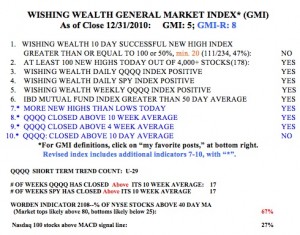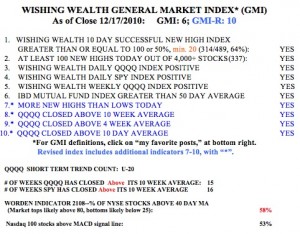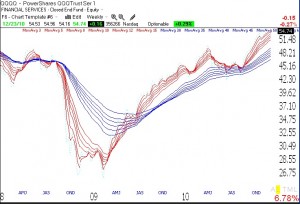There was weakness in the leaders on Friday with all nine stocks declining, and five of them have closed below their 30 day averages. Only 28 of the Nasdaq 100 stocks rose.  Furthermore, only 27 of the Nasdaq 100 stocks closed with their MACD above its signal line, reflecting short term weakness. Nevertheless, the short and long term trends of the major indexes (SPY, DIA, QQQQ) remain up. I am invested 100% in mutual funds in my university pension, but in my IRA trading account I am holding long positions that are largely protected by put options. As I explained in a post in 2009, buying puts for insurance is an effective strategy for controlling risk, especially for large long positions. I am uncomfortable when market leaders like NFLX, CMG and BIDU weaken.
Furthermore, only 27 of the Nasdaq 100 stocks closed with their MACD above its signal line, reflecting short term weakness. Nevertheless, the short and long term trends of the major indexes (SPY, DIA, QQQQ) remain up. I am invested 100% in mutual funds in my university pension, but in my IRA trading account I am holding long positions that are largely protected by put options. As I explained in a post in 2009, buying puts for insurance is an effective strategy for controlling risk, especially for large long positions. I am uncomfortable when market leaders like NFLX, CMG and BIDU weaken.
General Market Index (GMI) table
End of year and quarter
Chances are we might have some more strength in the leaders of the past year, as mutual funds close out their 4th quarter portfolios. The funds want to hold winners and shed the losers. Thursday was the 24th day of the current QQQQ short term up-trend. As this weekly GMMA chart of the QQQQ shows, the Nasdaq 100 index remains in a strong RWB up-trend.
All indicators remain positive. Bullish sentiment high.
The GMI and GMI-R remain at their maximum values.  The last 2 weeks of December may bring strength for the leaders as mutual funds acquire them as part of end-of-quarter window dressing. The only warning signal I see now is the rise in bullish sentiment. The latest Investors Intelligence poll shows 56.7% of advisers are bullish. Rates near 60% often come near market tops. However the Worden T2198 indicator is only at 58%, in neutral territory. The key for me is to wait for a definite change in trend and not to try to anticipate one. So, I remain 100% long in my university pension and hold a position in QLD in my IRA trading account.
The last 2 weeks of December may bring strength for the leaders as mutual funds acquire them as part of end-of-quarter window dressing. The only warning signal I see now is the rise in bullish sentiment. The latest Investors Intelligence poll shows 56.7% of advisers are bullish. Rates near 60% often come near market tops. However the Worden T2198 indicator is only at 58%, in neutral territory. The key for me is to wait for a definite change in trend and not to try to anticipate one. So, I remain 100% long in my university pension and hold a position in QLD in my IRA trading account.
